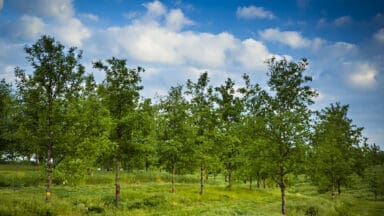
This week, the Soil Association and Woodland Trust brought together farmers, foresters and environmentalists at Woodoaks Farm in Hertfordshire to share knowledge and inspiration on the economic benefits of agroforestry.
After record breaking temperatures and drought this year, discussions at the show centred on the benefits of trees to provide shelter for livestock and crops, while also providing fodder when grass availability is limited. Farmers also shared insights on how trees boost milk yields and fix nitrogen, plus ideas around new crops that are becoming more viable as temperatures rise, such as almonds, walnuts, persimmons, and even olives. Talks and farm walks provided advice on techniques such as alley cropping with trees within fields, to better maintenance of hedgerows and farm woodland, including timber opportunities.
“The second Agroforestry Show has been another roaring success and the discussions of the benefits of trees have never felt more relevant after such a challengingly dry year. A growing movement of farmers and foresters are realising how much our farmed landscape needs to incorporate more trees to protect our food security. There are challenges ahead but it’s not all doom and gloom – there are huge opportunities with tree crops that weren’t viable here before. Every farmer has trees they could be making better use of, or areas where they could plant new ones. But the situation is urgent and the time to get moving on agroforestry is now,” said Ben Raskin, Head of Agroforestry at the Soil Association.
Helen Chessire, Lead Policy Advocate for the Woodland Trust, added: “We’ve had another fantastic Agroforestry Show and what’s been brilliant this year is that we’ve seen discussions evolve from last time. There has been a new depth to discussions. We have moved past exploring what agroforestry is and why it’s important – now we are onto how to get it done at scale. The advice hub, training hub and demonstration area have been popular which really shows the appetite that farmers have to lead the charge on getting more trees into our farmed landscape. We desperately need this to protect both UK food production and nature.”
Uncertainty around government support with the Sustainable Farming Incentives was also a key theme, with both charities offering advice of funding streams that are still available. Martin Crawford, founder of the forest garden at the Dartington Estate and the Agroforestry Research Trust, urged farmers not to wait for government funding.
He said: “We need to do the right thing now whether or not the grant system pays us for it. We have to take action if we want our farms and businesses to survive. There are risks whatever we do or don’t do, but I do actually think the risks of not doing something are much greater now. Doing nothing is not really an option anymore. I don’t think we can use the past climate as a guide to the future of growing after a year like this where everything has gone haywire. There’s an urgency to this because trees and perennial crops take some time to establish so I would just say don’t delay, get something started.”
Information provided at the sessions, including on private and public funding streams, is available on the Agroforestry Show website, with the organisers confirming that more detail will be added in the coming weeks.
Agroforestry in practice
In 2022, the farming company, Riverford embarked on an inaugural agroforestry project, planting some 1500 nut trees across four of their farms. Since then, the organic farm has planted over 16,000 trees, consisting of a mixture of woodland and agroforestry, to help sequester carbon, improve the soil and boost biodiversity. Nut trees have not only provided a new crop, but through perennial cropping have also reduced the need for soil disturbance. Latest reports show that the project is proving successful, despite the dry summers and already producing a crop for the farm. The farm is currently looking into effective, mechanical harvesting methods to ensure the crop is competitive.

